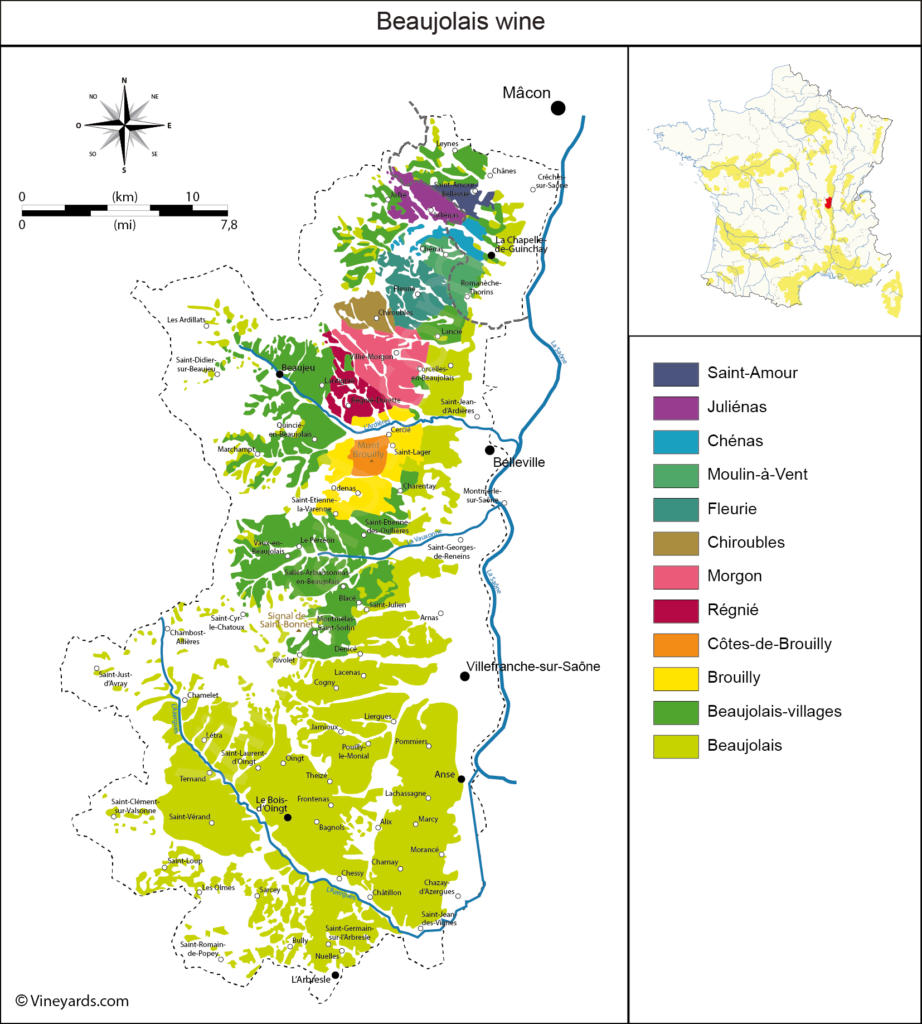Beaujolais.
Beaujolais is almost synonymous with Gamay (or, more precisely, Gamay noir à Jus blanc), the most important grape variety in the area. It accounts for 98% of the total production.
Beaujolais is a wonderful (and often misunderstood) wine region north of Lyon, encompassing part of the northern Rhône region and overlapping with the southern areas of Saône-et-Loire in Burgundy.
Gamay
Now understood to be a cross between Pinot Noir and the old white grape variety Gouais, it produces a rich harvest and ripens two weeks earlier than Pinot Noir. This results in fruity wines with low alcohol and tannin content, high acidity and light to medium body.
It was a happy encounter between Beaujolais and Gamay. The grape variety was also badly treated and driven out of Burgundy as early as 1395 to make way for the more famous and valuable Pinot Noir. Pushed south, it found in Beaujolais the granite soil and warmer temperatures on which it thrives.

Philip the Bold
In a famous decree in 1395, the Burgundian ruler forbade the cultivation of Gamay in the Côte-d'Or, arguing that it was harmful to human health. He even called the grape "dishonourable" ("l'infâme et déloyal Gamay").
Gamay even benefited from this displacement because it thrives even better on the granite slopes of the Beaujolais than on the limestone quarry of the Côte-d'Or.
Mention should also be made of a small production of Chardonnaywhich is usually marketed under the more familiar name of Mâcon-Villages or Saint-Véran due to the almost 100 communes in the north of Beaujolais that overlap with the Maconnais area of Saint-Véran.
Topography and soils
The wine region is divided into two parts, which is made clear by the location of the different appellations.
Bas Beaujolais in the south, mainly flat and with rich soils of sandstone and clay. Here the notorious Beaujolais Nouveau produced under the AOC Beaujolais.
In the northern part, roughly oriented towards the town of Villefranche, is the largest part of the Beaujolais-Villages AOC and the Cru Beaujolais AOC. Here the soils are mainly slate and granite with some limestone.
The Crus
Under the AOC Cru Beaujolais there are real and still underestimated pearls of French viticulture spread over 10 areas (in Beaujolais, the term "cru" refers to an area and not a single vineyard):

Brouilly, Régnié and Chiroubles produce lighter wines; Côte de Brouilly (higher slopes of the extinct volcano Mount Brouilly), Fleurie and Saint-Amour produce medium-bodied wines.
The other four crus offer full-bodied wines that can be drunk between four and ten years after harvest: Chénas, Juliénas, Morgon and Moulin-à-Vent.

Old Gamay vines in Juliénas
Juliénas is one of the most diverse areas in the Beaujolais region. It includes granite soils in the west, old alluvial soils in the east and some sandy soils with a clay content of up to 30 percent.
Below we go into more detail about two wines from Juliénas.
Two wines in comparison
A little insight into the Cru Juliénas from the wineries Bret Brothers and Romanesca. Here we look at two different (but each exceptionally good) vintages 2018 and 2019.

ROMANESCA
Les Fouillouses 2018, Juliénas
The 2018 vintage was very balanced between a wet winter and a hot, dry summer. Thanks to the good water supply in the first part of the year, the wines were fresh and lively with a slightly low alcohol content.
The Romanesca "Les Fouillouses" 2018 Fully confirms expectations with a deep ruby red wine that opens after some time on the nose with fresh notes of sage and orange, followed by blackberry jam, black cherry jam, violets and wild rose.
The mouth is infused with a broad acidity that balances alcohol and tannins well. Notes of blackcurrants, red roses and a hint of vanilla and marzipan on the finish.
Personally, I am very curious to taste this bottle again in 2024 and 2026.

BRET BROTHERS
Climat La Bottière 2019, Juliénas
The 2019 vintage was equally great, but certainly more complicated by severe frost in April, a very hot July and a rainy second half of August. However, the crus of the region were not so affected and the rain was very welcome as a relief after the hot weather. The result is fresh but concentrated wines.
The The Bret Brothers' "La Bottière" 2019 beautifully expresses this idea of concentration, starting with a nose that shows a wide range of red fruits one after the other: Wild strawberries, ripe strawberries, dried red currants. Violets, thyme and black pepper complete this wonderful carousel.
In the mouth, it is warm, balsamic with a delicate acidity that supports a long, spicy finish. Here we find wild berry jam and black pepper again, but also cinnamon, Virginia tobacco, dried plum and coffee.
Already, it is incredibly pleasant and seductive. Even if it can stand a longer bottle ageing, it will be hard to be patient.
Beaujolais offers the full range of affordable red wines – from drinkable picnic companions to complex terroir wines.
Text and wine expertise: Jonathan Gobbi
Photos: Michael McKechnie and Weekend Wayfarers at Creative Commons 2.0
Copyright: Taits UG, LebendigeWeine.de
